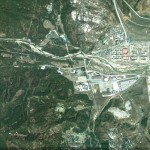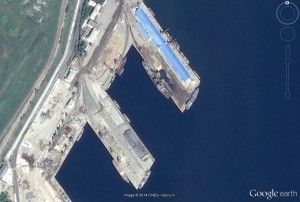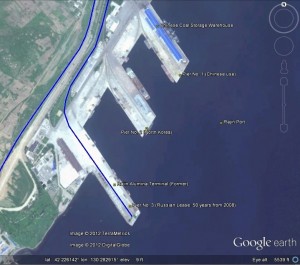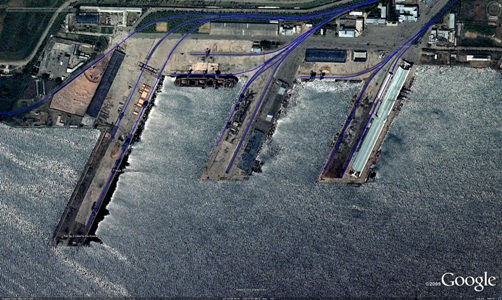UPDATE 3 (2014-4-23): Michael Madden and Ruediger Frank have published articles in 38 north analyzing the “election” results.
UPDATE 2 (2014-4-17): 3th Supreme People’s Assembly Holds First Session, Few Changes in Pak Pong Ju’s Cabinet
Institute for Far Eastern Studies (IFES)
The first session of the 13th Supreme People’s Assembly (SPA) held by the Kim Jong Un regime concluded on April 9, 2014 showing no major personnel changes within the Cabinet. The existing regime will continue to lead the North Korean economy, and their recent economic reform measures are expected to gain momentum.
At this session, it was decided that North Korea will retain Prime Minister Pak Pong Ju as leader of the Cabinet, and that many of the other high-level officials will maintain their positions in economic affairs.
It is therefore expected that the Kim Jong Un regime’s economic reform measures, such as the expansion of farmers’ authority (through the Subworkteam Management System), the construction of economic development zones (EDZs), and the system promoting the independent economic management of factories (and all other production facilities), will be implemented smoothly and stably.
It is also expected that North Korea will ramp up the implementation of its economic management improvement measures due to their recent success, which exceeded the state’s expectations. This directly coincides with the decision to retain Pak Pong Ju as Premier, and is an effort to secure the stability, continuity and longevity of North Korean economic policy.
Only three high-level officials in the economic department were replaced at this first session of the SPA: Han Yong Guk replaced Kim Kwang Yong as the forestry minister, Kim Chon Gyun replaced Paek Ryong Chon as the President of the Central Bank, and Ri Je Son was appointed as the Minister of Atomic Energy Industry.
The Ministry of Atomic Energy Industry is presumed to be an expanded and reformed version of the General Bureau of Atomic Energy (GBAE), which previously operated as an entity under the Cabinet. Established in 2013 at the 7th session of the 12th SPA, the Ministry of Atomic Energy Industry is responsible for North Korea’s nuclear program, nuclear policy, and the “byungjin line”, a policy that emphasizes the parallel development of economy and nuclear weaponry.
In 2013, the Korean Central News Agency (KCNA) announced the establishment of the Ministry of Atomic Energy Industry, saying it will “both modernize and systemize the nation’s atomic energy industry.” In the announcement, the KCNA also said, “because [the Ministry] has been founded on a firm base of cutting-edge technology, both the production and quality of nuclear materials will increase, and development will be made in self-sustaining nuclear powered industries.”
The newly appointed Ri Je Son has served as the General Director of the GBAE since 1997, and was the target of United Nations Security Council sanctions after North Korea’s second nuclear test in 2009.
Han Yong Guk has risen up through the ranks in the forestry sector, and Kim Chon Gyun has previously served as both director and vice-president of the Central Bank of the DPRK.
These small changes in Cabinet personnel do in fact signify efforts to maintain the stability of the nation’s economic policy, but the fact that these changes are so few in number also signifies that, after the execution of Jang Song Thaek, “re-shuffling” of personnel within the Cabinet had already taken place to some degree.
Before his execution, Jang Song Thaek had influences on many ministries within the Cabinet, including the ministries of commerce, metal and coal industries, and the Cabinet’s Extractive Industries. Since his execution, North Korea has replaced the head of these ministries.
UPDATE 1 [1st session of SPA] (2014-4-9): KCNA has posted many articles on the first session of the SPA. I have archived the important ones below:
Story 1: 1st Session of 13th SPA of DPRK Held (KCNA) (PDF). Notes: Kim Jong-un elected as First Chairman of the NDC. State posts determined. One interesting agenda item was not elaborated on: “2. Election of the State Guidance Organ of the DPRK”.
Story 2: DPRK National Defence Commission Elected (KCNA):
Pyongyang, April 9 (KCNA) — The following National Defence Commission was elected at the First Session of the 13th Supreme People’s Assembly of the DPRK:
First chairman of the NDC of the DPRK Kim Jong Un
Vice-chairmen of the NDC Choe Ryong Hae, Ri Yong Mu and O Kuk Ryol
Members of the NDC Jang Jong Nam, Pak To Chun, Kim Won Hong, Choe Pu Il and Jo Chun Ryong.
Yonhap reports on Choe Ryong-hae:
Choe Ryong-hae, a top military official, has become a truly influential figure second to only North Korean leader Kim Jong-un on April 9 when the newly launched North Korean parliament elected him as new vice chairman of the communist country’s most powerful body, National Defense Commission (NDC), during its first session.
…
Choe, the director of the North Korean army’s General Political Bureau, took up the mighty post that had been kept vacant since Jang Song-thaek, a powerful uncle of the North Korean leader, was executed on treason charges in December.
…
With his NDC appointment, Choe has grabbed all of the No. 2 positions of the North’s three core power bodies, the Political Bureau of the Workers’ Party’s Central Committee and the party’s Central Military Commission.
Story 3: Presidium of Supreme People’s Assembly of DPRK Elected (KCNA):
Pyongyang, April 9 (KCNA) — The following Presidium of the Supreme People’s Assembly of the DPRK was elected at the First Session of the 13th Supreme People’s Assembly:
President of the Presidium of the SPA of the DPRK Kim Yong Nam
Its Vice-Presidents Yang Hyong Sop and Kim Yong Dae
Its Honorary Vice-Presidents Kim Yong Ju and Choe Yong Rim
Its Secretary General Hong Son Ok
Its Members Kim Yang Gon, Thae Jong Su, Jon Yong Nam, Hyon Sang Ju, Ri Myong Gil, Kim Jong Sun, Kim Wan Su, Ryu Mi Yong, Kang Myong Chol, Kang Su Rin and Jon Kyong Nam.
Story 4: Members of DPRK Cabinet Appointed (KCNA) (PDF).
Yonhap reports:
Meanwhile, the North apparently opted for stability by making no dramatic changes in a Cabinet shakeup, which the parliament rubber-stamped during its session.
The North’s octogenarian titular head of state, Kim Yong-nam, retained his position as president of the Presidium of the Supreme People’s Assembly, with Premier Pak Pong-ju also keeping his job.
What is notable is that the North replaced its foreign minister. Ri Su-yong, a former ambassador to Switzerland, was named to replace Pak Ui-chun as the top diplomat of the communist country.
Ri is known to have served as a guardian of leader Kim and his younger sister Kim Yo-jong when they studied at an international school in Switzerland in the 1990s.
NK News reports on other changes:
Mun Myong Hak replaced Ri Yong Yong as Minister of Coal Industry
Kim Yong Gwang replaced Han Hyo Yon as Minister of Metallurgical Industry
Ri Hak Chol replaced Kang Min Chol as Minister of Mining Industry
Han Ryong Guk replaced Kim Kwang Yong as Minister of Forestry
Kim Kyong Nam replaced Ri Song Ho as Minister of Commerce
Pak Chun Nam replaced Hong Kwang Sun as Minister of Culture
Kim Chon Gyun replaced Paek Ryong Chon as President of the Central Bank
Pak Myong Chol replaced Kim Pyong Ryul as President of the Supreme Court (not a cabinet position)
Story 5: Director of Supreme Public Prosecutors Office Appointed, President of Supreme Court Elected (KCNA)
Pyongyang, April 9 (KCNA) — The 1st Session of the 13th Supreme People’s Assembly of the DPRK appointed Jang Pyong Gyu as director of the Supreme Public Prosecutors Office and elected Pak Myong Chol as president of the Supreme Court.
Story 6: Panel Committees of SPA of DPRK Elected (KCNA)
The following Legislation Committee and Budget Committee, panel committees of the Supreme People’s Assembly of the DPRK, were elected at the 1st Session of the 13th SPA of the DPRK:
Legislation Committee of the SPA of the DPRK
Chairman Choe Pu Il
Members Jang Pyong Gyu, Pak Myong Chol, Pak Thae Dok, Thae Hyong Chol, Cha Hui Rim and Pak Myong Guk.
Budget Committee of the SPA of the DPRK
Chairman O Su Yong
Members Pak Yong Ho, Kye Yong Sam, Hong So Hon, Kim Hui Suk, Choe Yong Il and Pak Hyong Ryol.
Story 7: Statistics on the SPA members (KCNA)
The elected deputies to the SPA are the genuine people’s representatives who are devoting themselves to strengthening the DPRK government and accomplishing the revolutionary cause of Juche, remaining loyal to the idea and guidance of supreme leader Kim Jong Un.
Among the SPA deputies are anti-Japanese revolutionary fighters who participated in the anti-Japanese armed struggle led by President Kim Il Sung and veterans of the Fatherland Liberation War.
17.2 percent of the deputies are service personnel who are performing shining feats at posts to defend the country and worksites to build a rich and powerful country, true to the Songun revolutionary leadership of Supreme Commander Kim Jong Un.
Workers account for 12. 7 percent, cooperative farmers 11.1 percent and women 16.3 percent. They are bringing about shining labor innovations in the van of the heroic advance to build a thriving socialist nation.
Also among the deputies are officials of the party and power bodies, administrative and economic organs and working people’s organizations, those in the fields of science, education, public health, literature and arts and media and various other sectors and those of the General Association of Korean Residents in Japan and organizations under it.
Winners of Order of Kim Il Sung, Kim Il Sung Prize, Order of Kim Jong Il and Kim Jong Il Prize account for 30.2 percent, recipients of the titles of the DPRK hero and labor hero 14. 6 percent and recipients of academic degrees and titles including professors and doctors and scientists, technicians and experts 91.7 percent.
3.9 percent of the deputies are aged below 39, 66.9 percent 40-59, 29.2 percent above 60 and 94.2 percent of them graduated from universities or received similar level of education.
Story 8: Report on Implementation of State Budget for 2013 and State Budget for 2014 (KCNA)(PDF).
16% of the total expenditure was spent for national defence, thus contributing to smashing the enemies’ reckless moves to ignite a nuclear war and the anti-DPRK confrontation racket and powerfully demonstrating the dignity and might of the DPRK.
45.2% of the total expenditure went to the field of economic construction to consolidate the foundation of the self-supporting economy, bring a surge in the production in various fields of the national economy including agriculture and usher in a heyday in construction.
38.8% of the total expenditure was spent for the field of cultural construction including education, healthcare, sports and music and arts, contributing to the enforcement of popular policies and the building of a highly-civilized socialist nation.
This year’s state budgetary revenue and expenditure have been shaped in such a manner as to meet the financial needs for realizing the Party’s plan to build a thriving nation as early as possible and carrying out the national economy plan.
The state budgetary revenue is expected to grow 4.3% over last year. Out of this, transaction revenue is expected to swell 4.5%, the revenue from the profits of state enterprises 7.9%, that from the profits of cooperative organizations 4.8%, that from real estate rent 9.5%, that from social insurance 5.1%, that from sale of properties and price differential 2.4%, other revenues 1.7% and the revenue from economic and trade zone 5.1%.
This year’s state budget envisages that provinces, cities and counties will ensure the expenditure with their own incomes and deliver revenue to the national budget for their fulfillment of the plan for local budgetary revenue and expenditure.
The state budgetary expenditure is expected to increase 6.5% over last year. Out of this, spending for the fields of agriculture, stockbreeding and fishery is expected to go up 5.1%, that for capital construction 4.3%, that for science and technology 3.6%, that for the vanguard sector of the national economy and the fields of basic industry and light industry 5.2%, that for education 5.6%, that for healthcare 2.2%, that for social insurance and social security 1.4%, that for sports 17.1% and that for culture 1.3%.
15.9% of the total state budgetary expenditure is expected to be spent for national defence this year and a huge amount of educational aid fund and stipends is to be sent to the children of Koreans in Japan.
According to the Wall Street Journal’s Korea Real Time:
The last publicly available figure for Pyongyang’s annual budget, in 2008, was 451.3 billion North Korean won. Based on the latest available market rate, that would be roughly equivalent to $61.8 million. Using that figure to calculate spending on national defense would give a figure of around $8.65 million.
Here are the pictured from Rodong Sinmun:
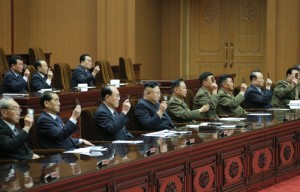
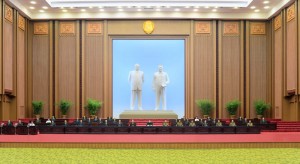
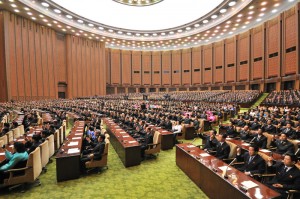
ADDITIONAL INFORMATION:
1. The Daily NK has an interview with a participant in the 12th SPA.
2. Here is 13th SPA “election” coverage.
ORIGINAL POST [Politburo] (2014-4-9): KCNA reports on the meeting of the Political Bureau of the Worker’s Party:
Meeting of Political Bureau of C.C., WPK Held under Guidance of Kim Jong Un
Pyongyang, April 8 (KCNA) — A meeting of the Political Bureau of the Central Committee of the Workers’ Party of Korea was held under the guidance of Kim Jong Un, first secretary of the Workers’ Party of Korea, first chairman of the National Defence Commission of the DPRK and supreme commander of the Korean People’s Army, on April 8.
It was attended by members of the Presidium of the Political Bureau of the C.C., the WPK, and members and alternate members of the Political Bureau of the C.C., the WPK.
Vice-premiers of the Cabinet and some department directors, first vice-department directors and vice-department directors of the C.C., the WPK were present at the meeting as observers.
The meeting discussed the issue of reinforcing the organization for increasing the leadership role and function of the Party as required by the developing revolution.
It discussed a proposal for forming the state leadership body to be submitted to the First Session of the 13th Supreme People’s Assembly.
It also discussed an organizational matter.
Decisions on the relevant agenda items were unanimously adopted at the meeting.
Kim Jong Un at the meeting set forth important tasks to be fulfilled to further strengthen the WPK to be an invincible revolutionary party, firmly protect the dignity and sovereignty of the country and dynamically accelerate the work to improve the standard of the people’s living and the building of a rich and powerful country.
The meeting held under the guidance of Kim Jong Un marks a historic occasion that encouraged the service personnel and people in the struggle to dynamically advance along the road of independence, Songun and socialism under the uplifted banner of great Kimilsungism-Kimjongilism and provided an important milestone in bringing earlier the building of a thriving nation and a great revolutionary event of national reunification.
Here are photos from Rodong Sinmun:
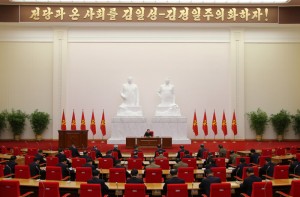
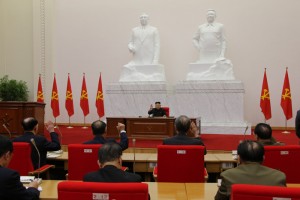
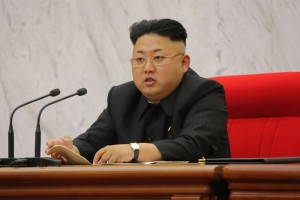
Here is coverage in the Daily NK.
Read the full story here:
Meeting of Political Bureau of C.C., WPK Held under Guidance of Kim Jong Un
KCNA
2014-4-8

